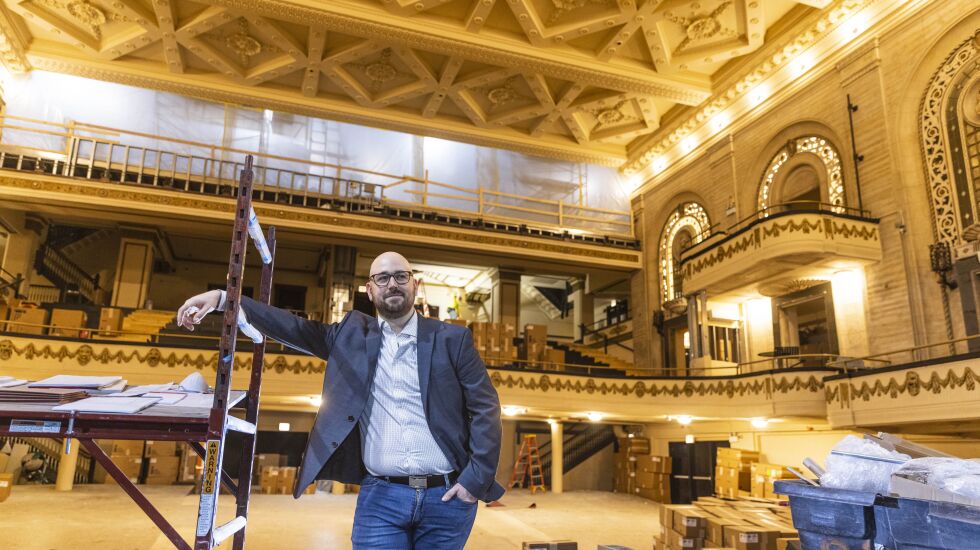
Brittle scraps of Scotch tape stick to the marble walls, chipped and gouged from decades of comings and goings — and if it were any darker in the lobby of the Fine Arts Building on South Michigan Avenue, a flashlight might come in handy.
On the lobby’s west wall in small, tarnished lettering, it reads: “The Studebaker” above papered-over doors — a reminder of the building’s earlier life, stretching back to the late 1800s when it housed Studebaker buggies and wagons.
But then, a wafting odor of epoxy and the muffled growl of a drill, and it’s clear something is happening on the other side of those doors.
Inside, hidden almost in plain sight, is the newly renovated Studebaker Theater. With its glittering mirrored walls and ice-white lighting, the grand old theater once again radiates a kind of frosty warmth.
“It’s unique. I’ve been thinking about this for a while, and I don’t know that I’ve found a true comparison [in Chicago] because there are few theaters that are this grand but of this size,” said Jacob Harvey, the theater’s managing artistic director, leading a tour last week of the all-but complete multi-million dollar, two-year renovation.
By “this size,” Harvey means the relatively small capacity. It has 600 seats now, though when the theater first opened back in 1898, it could seat about 1,300 people. That’s back when patrons were jammed in up to the rafters. It opened only five years before the Iroquois Theater went up in flames during a performance, killing 602 of the 1,700 attendees.
“This was also the very early years of theater technology. There were still early experiments in terms of lighting and sound,” said Tanya Palmer, a Northwestern professor and Chicago theater historian. “A lot of what people would go to see were music-hall kind of experiences. … It was quite an event to go to this space.”
Though The Studebaker, 410 S. Michigan Ave., has hosted live events in recent years, it hasn’t been “fully functional” since the early 1980s when it was chopped up and converted into an art-house cinema. It closed in 2000, Harvey said.
But in its heyday, some of Hollywood and American theater’s biggest names appeared on stage, including Yul Brynner, Henry Fonda, Peter O’Toole, Louis Gossett Jr., and a young Martin Sheen.
Other somewhat less illustrious entertainers also performed there, including “Dr. Harlan Tarbell,” an illusionist famed for his “eyeless vision.”
Chicago native Mike Nussbaum, still acting at 98, remembers working at the Studebaker when he was a kid.
“If you went downtown to the Studebaker and wore a white shirt and dark pants with a tie, then they let you work in the upper balcony as an usher — and you got to see the show free,” said Nussbaum.
Nussbaum, who grew up in the Albany Park neighborhood, remembers seeing Hamlet there in the 1930s, with Ian Keith, a well-known Broadway and silent film actor.
“It was heaven,” Nussbaum said. “The opportunity to do that kind of work [as an actor] struck me even then as something I wanted desperately to do.”
On a recent tour, Harvey was keen to emphasize the state-of-the-art technology embedded, mostly unseen, within the theater. Where clunking metal levers once controlled the stage lighting, now it’s mostly done with computer touch screens.
“Basically everything is new, with the exception of the physical architecture itself,” Harvey said.
What hasn’t changed, Harvey said, is the expectation the theater will return to its 125-year-old theater roots, offering locally produced shows and those coming from out of town.
This month, a new musical, “Skates,” opens, billed as “‘Grease’ meets ‘Hairspray,’ with a dash of Xanadu!’”
The Studebaker is also set to become the new home of the Chicago-based NPR quiz show, “Wait Wait … Don’t Tell Me!”
Despite the pandemic and the theater’s history of sometimes struggling to find audiences, Harvey said now is as good a time as any to reopen.
“There is something incredibly ephemeral and uniting about being in the theater and having that shared community experience that people have been craving and are continuing to crave,” Harvey said.







